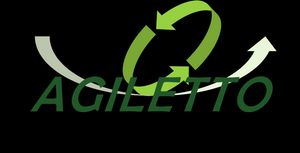Five Things Great Leaders Ask Themselves. Daily.
Leadership isn't just about guiding a team or setting a vision. It's about constantly challenging your assumptions and asking yourself: Am I truly leading, or am I merely managing? Whether you helm a traditional hierarchical structure, an agile team, or are pioneering a shift to a Teal organization, these daily self-reflective questions will help you not just lead—but transform. Do you dare to ask them? If so, let's do it!

Question No 1: Is the Vision Clear, Concise, and Ambitious Enough?
All teams and organizations need a vision. Or perhaps several visions: one for the organization itself, one for our team, and one for our product. They could be different but interconnected, or they could merge into one compelling narrative.
But here's a twist: Is the vision too comfortable?
If your vision doesn't make you a bit uncomfortable, if it does not create a tingling sensation in your stomach, is it really bold enough to drive meaningful change? Great leaders must ask themselves if their vision is not only clear and concise but also challenging enough to disrupt the status quo.
- Do we have a compelling vision?
- Have I communicated it enough?
- Do we need to update it to make it more challenging?
Question No 2: Do My Team Understand Their Purpose, and Is It Evolving?
According to Daniel Pink, purpose is one of three motivating factors for knowledge workers. But it's not enough for a team to have a purpose—it must be communicated, understood, and, crucially, evolving. The difference between the vision in the previous question and the purpose is that while the vision sets the future state, the purpose answers the question "Why?" They go hand in hand. Sometimes the purpose is called a mission or a mission statement; I like to call it the "Why," borrowed from Simon Sinek's Golden Circle concept.
In a Teal organization, the ego-driven desire for self-preservation found in many organizations' mission statements is replaced by a powerful drive to do work that has real meaning and purpose. This purpose isn't static; it evolves as the team grows and as the world changes. This practice is applicable in all kinds of organizations, teal or not, in my humble opinion.
- Do we have a clear purpose that resonates with everyone?
- Is our purpose static, or does it evolve with us?
- How can we make our purpose more adaptive and meaningful?
Question No 3: Are We Truly Empowering Our Teams, or Just Delegating Tasks?
Empowerment means more than just giving people the freedom to make decisions; it requires providing them with the tools, authority, confidence, and context they need to make those decisions effectively. However, are we confusing empowerment with delegation?
Empowerment is often touted but rarely understood in practice. When empowerment is confused with simple delegation, team members can feel abandoned, overwhelmed, and unsupported, lacking the resources or mandate to make impactful decisions. Leaders need to critically assess whether they are truly empowering their teams or merely handing off responsibilities without adequate support.
When teams lack trust from management, tools, or sufficient mandate, they often revert to old behaviors—seeking permission and waiting for managers to make decisions. In these situations, leaders should resist the urge to step in and make decisions. Instead, they should ask their teams what they need to feel confident making decisions independently.
- Are we providing the necessary context, training, and resources to empower decision-making?
- Do my team members feel they have the real authority to make decisions, or are they just executing tasks?
- How can I actively support my team in developing their decision-making skills and confidence?
- When mistakes happen, do I use them as learning opportunities or do I step in to fix the issue myself?
Question No 4: Do We Embrace Creative Tension, or Are We Afraid of Disruption?
Many leaders are uncomfortable with conflict and may even fear it. I was once among them. However, in a dynamic, agile, or Teal environment, creative tension—the constructive conflict that arises from differing ideas and perspectives—can be a powerful catalyst for innovation and growth. If everyone agrees all the time, it might indicate that your team is not pushing the boundaries of what is possible. When everyone just says yes, evolution stalls. This is precisely why diverse personality types and perspectives are valuable within teams.
Leaders need to create an environment where creative tension is not just tolerated but actively encouraged. This means fostering a culture where powerful, even provocative, questions are used as tools to stimulate innovative thinking and challenge the status quo.
- Am I fostering a culture where healthy debate and diverse opinions are not only welcomed but encouraged?
- Do I actively promote an environment where my team can challenge ideas—including my own—to find the best solutions?
- Are we becoming too comfortable with our current processes and avoiding the disruption that true innovation often requires?
- How do I respond to dissent or disagreement? Do I view it as a threat to my authority, or as an opportunity for growth and learning?
Question No 5: Are All Team Members Happy?
Happiness in a team is not just about avoiding discomfort or having fun all the time; it's about fostering a sense of fulfillment, engagement, and joy in the work being done. But leaders must ask themselves: Is the team's happiness genuine, or is it just a superficial comfort?
True happiness comes from a sense of achievement, purpose, and connection to the work and to each other. It’s not just about being free from conflict or challenges. A leader's attitude and behavior set the tone for the workplace culture. Even when the going gets tough—or especially then—leaders must nurture the culture by demonstrating positivity, optimism, and empathy.
Psychological safety and happiness in the workplace are closely connected. Psychological safety provides the foundation for an environment where employees feel secure, valued, and empowered, which directly contributes to their overall happiness and well-being. Without psychological safety, it is impossible to be happy.
- Are team members free to express themselves? Do they?
- Do they truly collaborate as a team, or are they just a group of individuals?
- Are team members finding joy and fulfillment in their work, or are they simply content with the status quo?
- Is there a sense of shared achievement and celebration of successes, however small?
- Am I fostering an environment where happiness is derived from meaningful engagement, rather than just comfort and ease?
- How do I recognize and celebrate genuine happiness within the team?
Conclusion
In the evolving landscape of modern leadership—whether agile, teal, servant, or intent-based—continuous self-improvement is not optional; it's essential. To grow as a leader, self-coaching is one effective strategy. So, select one or two of the questions above that resonate most with your current leadership challenges. Post these questions somewhere visible, so you're reminded daily to reflect on them.
But don’t stop at reflection—turn those reflections into action. Set specific, measurable goals based on your answers. For example, if you realize your vision isn't challenging enough, work with your team to revise it. If you find that empowerment is lacking, focus on building a more supportive decision-making environment.
Furthermore, embrace feedback—both from your team and peers. Encourage open dialogue about your leadership style and be willing to adapt based on what you learn. Remember, the journey to becoming a great leader is ongoing, fueled by curiosity, humility, and a commitment to continuous learning.
By asking yourself these questions and acting on your answers, you can foster a more engaged, empowered, and innovative team, ultimately leading to greater success and fulfillment for everyone involved.
References and Further Reading
- Laloux, Frederic. Reinventing Organizations. 2014.
- Pink, Daniel H. Drive: The Surprising Truth About What Motivates Us. 2009.
- Sinek, Simon. Start with Why: How Great Leaders Inspire Everyone to Take Action. 2009.
And some of my articles in the subject:
- The Subtle Art of Leading by Example—Even When No One is Watching
- The Power of Collaborative Decision-Making: Implementing the Advice Process in Teal Organizations
Picture: © Who Is Danny / Adobe Stock
Last updated May 27, 2025
